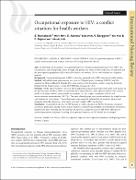| dc.description.abstract | Aim: To determine the frequency of occupational exposure to human immunodeficiency virus (HIV), the
circumstances and predisposing factors, the high-risk groups, the extent to which exposures are reported and
the post-exposure prophylaxis (PEP) utilized by health-care workers (HCWs) and students in a Ugandan
hospital.
Background: Occupational exposure to HIV is a low but potential risk of HIV infection to health workers.
Method: Self-administered questionnaire was given to 224 participants (including 98 HCWs and 126
students) in Mbarara Hospital, Uganda. Data were analysed with descriptive statistics using the Statistical
Package for the Social Sciences version 15.0 (SPSS Inc, Chicago, IL, USA).
Findings: Of the 224 participants surveyed, 19.2% reported having sustained injection needle stick injuries in
the previous year, of which 4.46% occurred with HIV-infected blood. Other reported injuries were cannula
needle stick injury (0.89%), suture needle stick injuries (3.13%), scalpel cut injuries (0.45%) and
muco-cutaneous contamination (10.27%). The most affected groups were nurses–midwives for scalpel injuries
and students for stick injuries. The predisposing factors reported included lack of protective devices and
recapping of needles. Exposures were under-reported. Uptake of PEP was also low.
Conclusion: Occupational exposure to HIV presents a conflict situation for HCWs. It remains a frequent
occurrence particularly among student nurses–midwives, despite being avoidable. Its prophylactic treatment is
hampered by poor reporting and investigation of exposures, and poor access to PEP. Strict adherence to
universal precaution and proper handling of occupational exposure to HIV should be encouraged. | en_US |

